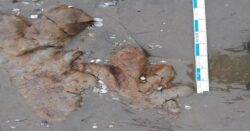A different kind of footprints has popped up on an Isle of Wight beach (Picture: JBA Consulting/Environment Agency)
‘Leave nothing behind but footprints’ is a common refrain on British beaches – and 125 million years ago a massive dinosaur did just that on the Isle of Wight.
Engineers on Yaverland seafront have discovered the telltale signs of what appear to be footprints of a mantellisaurus – a seven-metre long, plant-eating dinosaur – while working to improve sea defences.
The Cretaceous-era creature alternated between walking on four legs and two, with three toes on each foot.
The fossils were revealed tucked between the beach’s cafe, car park and bus stop – a stunning reminder of the giants that walked the planet long before humans were drinking tea.
‘The Isle of Wight is the richest dinosaur location in Europe, but this is still a wonderful find,’ said Dr Martin Munt, curator of the Dinosaur Isle Museum.
‘We have located 35 different types, and the area was once also heavy with plants, crocodiles, pterosaurs, amphibians, fish and invertebrates like insects and freshwater mussels.
The mantellisaurus skeleton on display at the Natural History Museum (Picture: NHM)
‘We cannot be totally sure about a print’s identity, but the three-toed feet makes it likely a mantellisaurus was here, not just in other parts of the south coast where they were more common – or that’s what we thought until now.’
If the prints are from a mantellisaurus, it will be something of a homecoming after the species was first discovered a little over 10 miles away on the other side of the island near Atherfield in 1914.
However, the bones were incorrectly identified as an iguanodon, and not until 2007 was the mantellisaurus classified as its own distinct species.
Mantellisaurus was discovered on the Isle of Wight – and now more traces seem to have been found (Picture: Getty/Stocktrek Images)
The sea defence work is being carried out by JBA Consulting on behalf of the Environment Agency (EA).
‘This represents a hugely important and significant discovery for the project, as finding the new footprints makes it clear that the land on which the dinosaurs walked is likely to stretch the whole length of Yaverland beach,’ said JBA heritage lead Stuart Noon.
‘Dinosaurs existing right where our team is working brings old and new together – the modern challenges of combating climate change with a period of time we can only imagine,’ said the EA’s Nick Gray, flood and coastal-risk manager for the Solent and South Downs area.
More: Trending
‘We’ve all read the stories and seen the films, but this gives us just a hint of what life was like.
‘Reducing coastal flood and erosion risk to island people, property and infrastructure is a priority for the Environment Agency, but we’ll continue to have more dinosaur discoveries in mind.’
The fossilised footprints are far from the only dinosaur discovery on the island this year alone.
Last month a new species of herbivore the size of a chicken called Vectidromeus insularis was discovered by an amateur collector, while in June the armour-plated Vectipelta barretti, a species of the lumbering ankylosaur, was unveiled by the Natural History Museum.
MORE : Did an asteroid wipe out the dinosaurs? Computer says no
MORE : Meet the ‘bloodthirsty’ beast that ruled 40 million years before the dinosaurs
MORE : Stunning fossil shows small mammals once hunted big dinosaurs
The island was once chock full of the giants.





